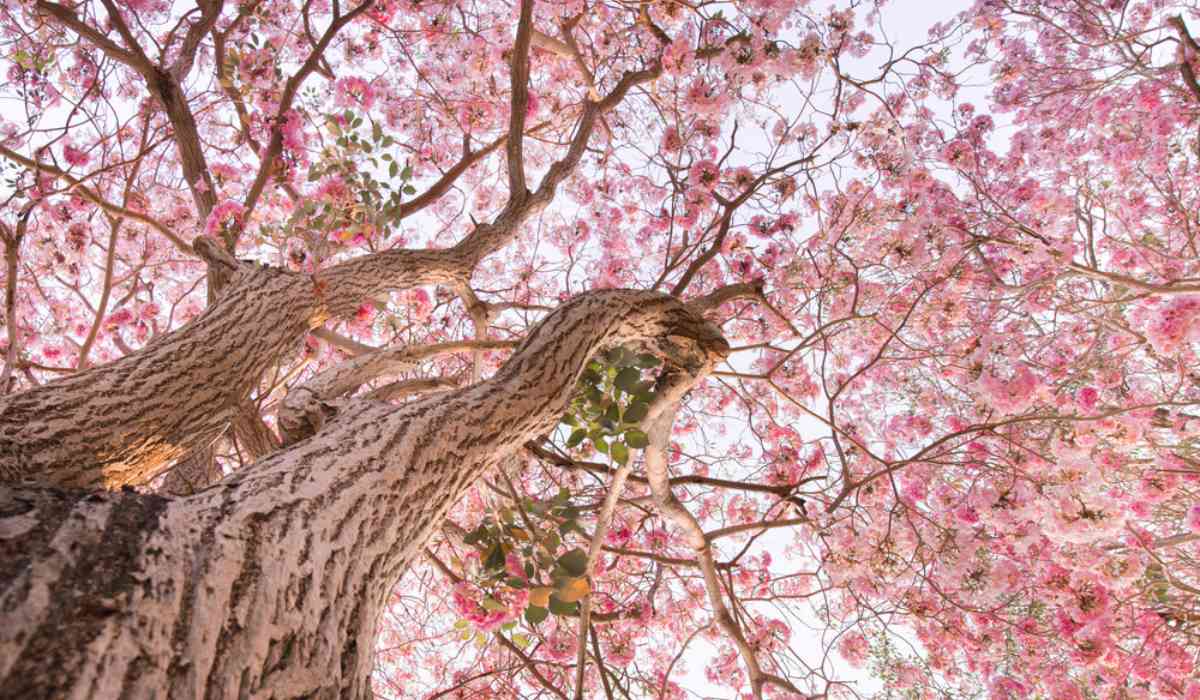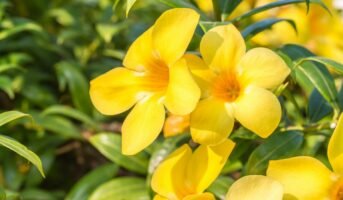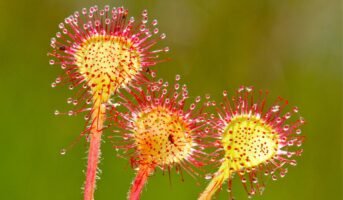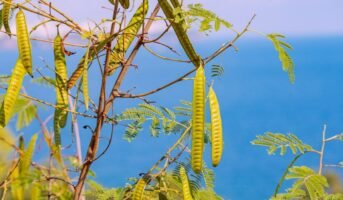Tabebuia Rosea (Pink Trumpet) or Tecoma Pink is an evergreen tree with a long, smooth trunk topped with a round, spreading crown. It is known for its stunning trumpet-shaped flowers of pink and white colours with yellow throats, which bloom in clusters. The leaves are oblong to ovate-elliptic, leathery, scaly and mid-to-dark green in colour. The flowers first occur after three years of planting. Tabebuia Rosea is usually planted along the roads and in parks and is considered deciduous in climates with a dry season. The rosy trumpet tree is the national tree of El Salvador. The flowers drop after a while and the grass patch beneath is covered with a carpet of flowers. It thrives well in moist or dry forests, often in open fields or along roadsides. All the leaves of the Tabebuia Rosea tree fall off in the blooming season, leaving behind clusters of beautiful purple-pink flowers. Most species of trumpet trees produce heavy spring blooms and tubular flowers with multiple stamens. Dolichandra unguis-cati belongs to the Bignoniaceae family as well. Learn more about it.
Also read about these Evergreen trees for small gardens
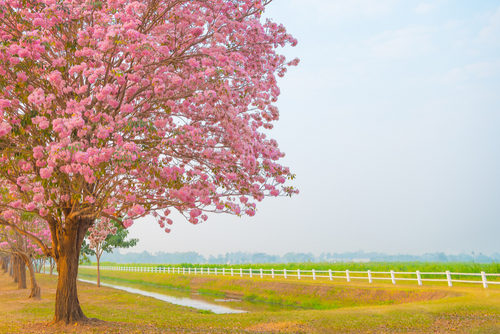
Known about Prunus Armeniaca
Facts about Tabebuia rosea
| Family | Bignoniaceae |
| Plant type | Flowering |
| Botanical name | Handroanthus Impetiginosus |
| Common name | Tabebuia Rosea, pink poui, rosy trumpet tree, Savannah Oak, Basant Rani (Hindi) |
| Native | It is a native of Mexico, Central America, Venezuela and Ecuador |
| Sun exposure | Full sun |
| Water | Moderate water |
| Mature size
|
20 to 40 feet |
| Flowering Period
|
Hot and dry period, after rain, a few times each year |
| Soil type | Fertile Soil
|
| Etymology
|
Genus name derived from the native Brazilian name, ‘tabebuia’ or ‘taiaveruia’
The species epithet ‘Rosea’ means rose-coloured. |
| Bloom | Bloom schedule depends upon the climate. It is usually spring and summer. Flowering occurs between January and April in India
|
| Flower colour
|
Pink.
The flower is trumpet-shaped with five petals, is 5-8 cm long, and is large and showy |
| Edible parts | None
|
| Uses | Shade-providing tree, the bark has anti-oxidant properties. The timber is used for construction and furniture. |
know about: Gular tree
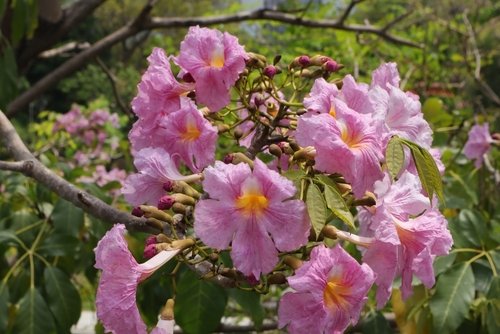
What is the common name for Tabebuia?
Tabebuia rosea is also called as Tecoma pink, pink poui and rosy trumpet tree.
Is Tabebuia a cherry blossom?
Tabebuia has pink flowers and is known as ‘Cherry Bloosoms of Penang’ as these pink flowers resemble Japan’s cherry blossom. But they are in actual not cherry blossom.
Are Tabebuia rosea and cherry blossom same?
No, Tabebuia rosea and cherry blossom are not the same. The Tabebuia rosea trees are found in Mexico, Venezuela and Ecuador.
Popular Tabebuia varieties
- Yellow trumpet tree (Tabebuia argentea)
- Pink trumpet tree (Tabebuia heterophylla)
- Cuban pink trumpet tree (Tabebuia pallida)
- Gold trumpet tree (Handroanthus chrysanthus, formerly Tabebuia chrysotricha)
- Silver trumpet tree (Tabebuia caraiba)
- Purple trumpet tree (Handroanthus impetiginosus, formerly Tabebuia impetiginosa)
- Caribbean Trumpet Tree(Tabebuia Aurea)
see also: Date tree: How to grow and care for the Khajur tree

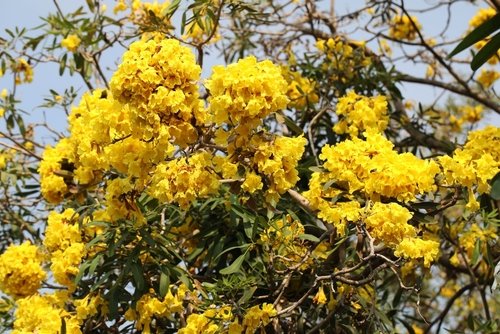
How to take care of Tabebuia rosea
Sunlight
Tabebuia Rosea prefers full sunlight. It needs 6-8 hours of direct sunlight a day. Tabebuia needs warm weather to thrive.
Soil and fertilizer
Plants that have a high drought tolerance prefer fertile soil with good drainage. In the growing period, feed the plant with a balanced liquid fertilizer, once in 1-2 months, to boost its growth.
Water
Follow a regular watering schedule that promotes deep root growth. As the tree takes root, water it twice per week, for the first two months. Once the tree has taken root, reduce watering to once a week but increase the volume of water. Seedlings and young plants require frequent, deep watering, especially during the first few months of growth. When growing from seed, start in a pot. Established trees do not need watering unless the region experiences a dry spell.
Pruning
Pruning dead wood and the brittle, old stem is an essential part of Tabebuia tree care. Prune the plant in dormancy to maintain its shape and size. Remove damaged or dead branches and stems for promoting full growth.
Pest and diseases
The plant is disease and pest resistant, a trait that is carried over to the timber. Use neem oil for deterring aphids and mealybugs, miticide for spider mites and manually remove slugs and snails. Tabebuia trees can be affected by the tobacco mosaic virus, which leads to blotching and stunted growth. Once affected, it cannot be improved.
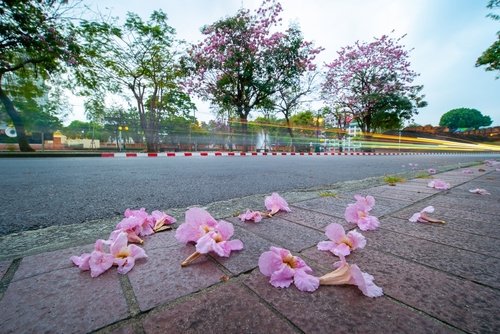
Is Tabebuia rosea poisonous?
While Tabebuia rosea may not be poisonous, one of the compounds that it has, known as lapachol is know to have toxic side effects and hence, use of Tabebuia rosea for cancer drugs are not completely preferred.
Uses of Tabebuia rosea
Tabebuia Rosea brings colour and vibrancy to any park or garden due to its bright flowers. This is a good roadside tree and suitable for growing in medium to large gardens. It is an important timber tree in Mexico and Central America that is used for construction, furniture, cabinet making, interior finish and boat and cart building. It is also used in traditional medicines. A decoction of the cortex is recommended for anaemia and constipation. A decoction of the flowers, leaves and roots is used to reduce fever and pain, treat tonsil inflammation and body pain.
Propagation of Tabebuia rosea
Bees pollinate the flowers, leading to smooth seed pods that yield large numbers of seeds. You can propagate the tree from both seeds and cuttings. To propagate with seeds, collect the seeds from the pods after they turn brown and start to crack open. Plant the seeds in pots filled with soil, placing the seeds about half-inch into the soil. Keep the soil moist. The seedlings would appear in four to six weeks. Once the leaves develop, transplant the seedlings outdoors. Container plants do not require transplanting until the root system starts to outgrow the container. Transplant in the spring after active growth starts.
To propagate from a cutting,
take 12-14 inches tall cuttings from mature shoots at the start of spring. Strip away the bark around the bottom and dip it in rooting hormone powder. Plant the cutting about an inch into a pot with standard potting soil. Keep the young plant moist as it takes root. It would about eight weeks for the plant to take root. It can be transplanted outdoors or into a larger container.
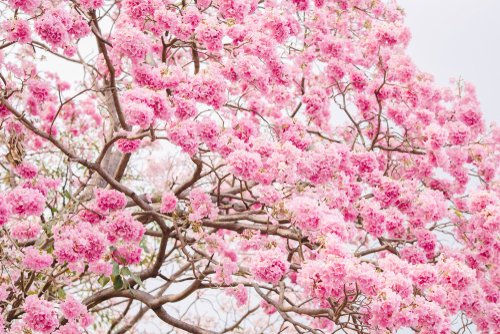
FAQs
Is Tabebuia cherry blossom?
No, Tabebuia is not cherry bloom. Tabebuia Rosea is often mistaken as the Cherry Blossom tree because of its pink flowers. But Tabebuia is native to large parts of South and Central America and Tabebuia Rosea are found in Mexico, Venezuela and Ecuador. A cherry blossom is from the Prunus tree and is found in the temperate climate of the Northern Hemisphere, including in Japan, China, Korea, Nepal, India and areas across northern Europe.
How fast does Tabebuia Rosea grow?
Tabebuia Rosea grows quickly. They start flowering in 2-3 years. The pink trumpet tree is a small to medium-sized tree that can grow 20-40 feet in height with a growth rate of 12-24 inches per year.
What colours do Tabebuia trees come in?
Tabebuia flowers grow in dangling clusters. The colourful flowers can be pink, white, bright yellow or lavender-purple. The tabebuia tree blooms before the leaves appear in spring.
Is Tabebuia Rosea evergreen?
Tabebuias are hardy, deciduous semi-evergreen flowering trees grown in warm regions throughout the world. Nearly a dozen species of Tabebuia are grown in India. The leaves are light green with three to seven leaflets. Flowers are produced in large clusters.
| Got any questions or point of view on our article? We would love to hear from you. Write to our Editor-in-Chief Jhumur Ghosh at [email protected] |
Purnima Goswami Sharma is a freelance writer based in Mumbai, who has been contributing to various newspapers, magazines and portals for the last two decades. Besides being a research writer for various TV shows, she has been a visiting faculty at SNDT for Communication Skills. She hold a master’s degree in English Literature from Mumbai University and a diploma in Communications and Journalism. She writes on diverse subjects like real estate, interiors, education, lifestyle, health, entertainment and environment.
Email: [email protected]
